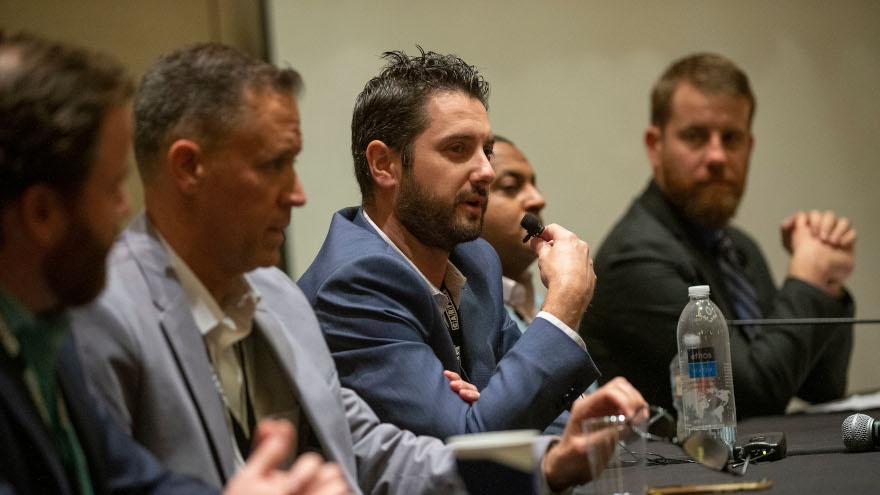COMMENTARY: Virtual platforms fill the gaps of physical auctions for buyers, sellers and auction houses

EBlock CEO Jason McClenahan (center, with mic) during a panel discussion at Used Car Week 2019. Photo by Jonathan Fredin.
The traditional automotive auction landscape has remained largely unchanged for quite some time, but as with every industry, technology offers opportunities to improve, innovate and push the industry forward.
With the digital landscape opening opportunity, many online auctions offered an entirely digital auction experience, attempting to replace while not effectively replicating the live experience. Still, live auctions have remained king.
Digital auctions, however, offer solutions to many of the challenges physical auctions face, and auction houses that choose to adopt a virtual platform as an extension of their already-successful live events — rather than a replacement for — will find better success in expanding their business, reaching more customers and hosting more successful auctions altogether.
Some of the frustrations sellers have with a physical auction occur due to its being held at a physical space, as well as waiting for the next live auction. When selling at a physical auction, dealers must relinquish control over their inventory during the shipping process, as well as incur some expense prior to selling the asset.
With a digital platform, sellers have more control over their inventory up until their vehicle crosses the virtual auction block, and because their vehicle remains in their possession before and during the auction, they can continue to offer it at retail up until auction day. While many dealers will still choose to ship inventory to a physical auction and see this as a major value proposition, a digital auction alongside a physical auction opens opportunity for dealers to choose which path best suits their business needs.
Physical auctions by definition come with physical boundaries; there are only so many prime run numbers and vehicles that can cross the physical block due to space limitations. Digital auctions empower auction houses to meet their customers where they want to do business.
Offering more vehicles from a wider geography than they previously pulled from will attract more buyers offering a stronger auction. Digital auctions are in fact digital and allow buyers and sellers to literally participate from anywhere; digital auctions expand an auction’s potential exposure, so rather than having a local or regional audience, a digital auction opens the door to a much larger audience.
While physical auctions are one of the most exciting and efficient live events you will have the opportunity to experience, digital platforms only build upon those efficiencies. At the very least, digital platforms offer a consolidated look at inventory and even the most basic platforms give typical digital retailing options such as notifications or search filters. The largest institutional buyers typically prefer digital auctions that replicate the tried-and-true process they experience at a physical auction with set auction times, run lists and vehicles bought and sold in 60 seconds.
At the end of the day, time is the most important piece of the puzzle. Buyers and sellers alike know the longer a vehicle sits in their inventory — whether offering at retail or shipping to/from an auction — the smaller their return on investment becomes. They also know that their time is money, and dealers are looking for auctions with options; live events and digital auctions until now were two different offerings.
A combined digital strategy, complimenting the physical auction experience is a winning service offering to the ever-changing needs of customers.
Jason McClenahan is president and CEO of EBlock.


